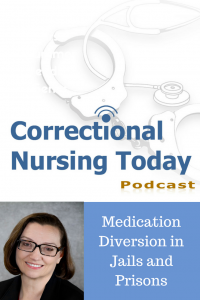 Jeffery Keller, MD, FACCP, CCHP-P, joins Lorry to talk about medication diversion in correctional facilities. Dr. Keller is Chief Medical Officer of Centurion as well as the Medical Director of Badger Medical, which provides medical services to several jails and juvenile facilities in Idaho.
Jeffery Keller, MD, FACCP, CCHP-P, joins Lorry to talk about medication diversion in correctional facilities. Dr. Keller is Chief Medical Officer of Centurion as well as the Medical Director of Badger Medical, which provides medical services to several jails and juvenile facilities in Idaho.
Incarcerated patients require medications to treat a variety of chronic conditions and injuries. In fact, medication administration is a primary role for correctional nurses, often taking up the majority of time for some. Certain patients, however, see an opportunity to continue their drug addiction or gain resources for the prison black market by diverting medication for their own uses. Prevented from obtaining illicit drugs as they might on the street, inmates may resort to engineering their medical experience to obtain mood-altering medications directly from your medical unit.
Diversion Methods
Cheeking is a common means of diversion where the patient pretends to swallow a medication but, instead, holds the pill in the cheek pocket for use later. Patients skilled in sleight-of-hand may pretend to put pills in their mouth when really keeping them in their hand to slide into a pocket. More unusual diversion methods include using an empty tooth socket or even swallowing and regurgitating the medication later (YUCK!).
The corrections community is split on the question of who is ultimately responsible for monitoring patients for medication diversion. In some settings, correctional officers are stationed at the med line and do a mouth check with every patient. In other settings, the nurse administering the medication is charged with observing that the medication is swallowed appropriately. Still other settings list this as a joint responsibility.
Popular Medications Targeted for Diversion
While there is variation among facilities and regions of the country, top desirable medications are usually those that have a psychoactive effect or side effect. Dr. Keller has found the following medication groups to be the most common targets in his experience.
- Sedatives such as trazadone, quetiapine, skeletal muscle relaxants, and psychotropics like Remeron and Elavil.
- Stimulants such as albuterol and pseudoephedrine
- Euphorics such as gabapentin, trazadone, and wellbutrin
- Psychedelics such as benadryl, chlorpheniramine, and ditropin
- Even Non-mood altering agents such as psyllium powder can be desirable. Psyllium powder can be mixed with water and molded into a shank.
Controlling Medication Diversion
Dr. Keller offers some wise advice on how to control medication diversion in correctional settings. How many of these interventions are you already doing?
- Know the commonly diverted medications in your particular setting. Consider the patient benefits compared to system harm in having these medications available.
- Look for less-abused alternatives to highly abused medications currently on the formulary. Many facilities are limiting the use of medications such as quetiapine in favor of alternatives such as zyprexa or haldol.
- Monitor prescription patterns through a strong Pharmacy and Therapeutics committee.
- Provide structured decision trees for the prescribing of highly abused medication to be sure the patient will really benefit from the medication.
What are common medications diverted in your setting? Have you seen some unusual diversion methods? Share your thoughts in the comment section of this post.
Laurie says
This is what i keep telling prescribers. As fast as i catch the guy diverting, the put him back on the same med. Ibwill be sharing this